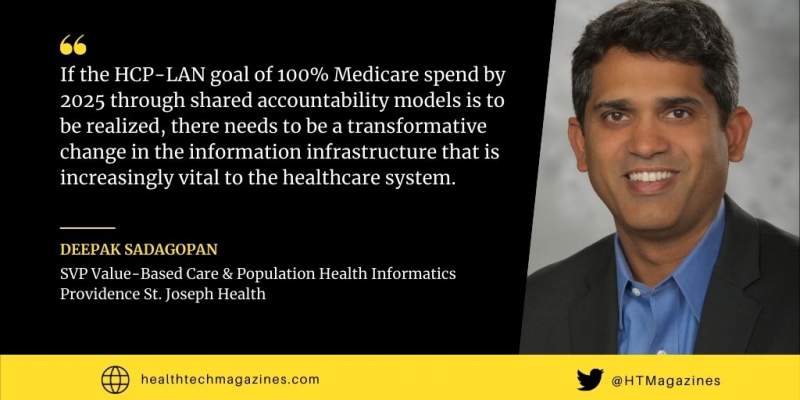Op-Ed – Technology opportunities to scale value-based care
By Deepak Sadagopan, SVP Value-Based Care & Population Health Informatics, Providence St. Joseph Health
One of the rare areas that has received bipartisan support from a federal policy perspective is the shift in healthcare payment models from Fee For Service (FFS) to a system that recognizes value and quality at the lowest cost. The Healthcare Payment and Learning Action Network (HCP-LAN), a consortium of public and private healthcare organizations supporting the adoption of alternative payment models, has set an ambitious goal. If the HCP-LAN goal of 100% Medicare spend by 2025 through shared accountability models is to be realized, there needs to be a transformative change in the information infrastructure that is increasingly vital to the healthcare system. While recent policy changes including the final interoperability rule, incentives to support the adoption of certified Electronic Health Records (EHR) and other initiatives do enable incremental progress, they stop short of addressing critical business process issues that impede scalability of value-based care delivery models. The COVID-19 pandemic and its impact on our healthcare system has accelerated the need to manage this shift in a scalable manner.
This shift to value-based care models has impacted providers, payers, and consumers in very specific ways:
- Provider – Under shared accountability models, payers hold providers accountable for meeting a specified population’s healthcare needs within a defined budget and quality targets. To do well under these models, at the very least, providers need to know who their patients are, and have visibility into the healthcare spend for these patients. Further, in contrast to FFS, these models require a pro-active engagement of assignment patients and management of chronic health conditions, including and especially when they are outside the traditional healthcare facility setting. Finally, providers need to develop deeper “information partnerships” with payers to manage health risks across a shared population jointly.
- Payers share the Providers’ need to arrive at a shared perception of members covered under a shared accountability model and inform providers periodically of membership changes. They seek deeper visibility into clinical data and share the Provider desire for better capabilities to automate manual processes involved in the review and authorization of care. They seek more intelligent capabilities that connect into the point of care to provide guidance on covered services for referrals and transparency into patient out of pocket costs.
- Consumer mostly face a bewildering array of choices among healthcare providers and services, with few tools to navigate them. With the rapid growth in high deductible plans and tiered networks, consumers need to know which service is covered under their plan for a given provider. They need to understand the quality measure jargon that they encounter when seeking a high-quality provider. They need to rely on estimates that the provider can offer at the point of care because, ultimately, the bill(s) they receive is/are different. The explanation of benefits they receive in the mail often requires further explanations. There is widespread frustration at the amount of administrative effort it takes to manage their HRA/HSA/FSA.
While there has been a lot of activity recently, particularly around the patient information access and interoperability policies, there remain significant areas of opportunity. I believe there are five specific areas of opportunity that offer strong potential for private-public partnerships:
- Payer-Provider interoperability – Despite recent activity around the use of FHIR-based standards, much of the standards that are in development and implementation perpetuate a FFS operating model. There needs to be renewed focus on developing machine-readable standards to support a population-based operating model including member identification & synchronization, quality and care gaps, and financial performance reporting. Much of this data exchange is manual today and where electronic exchange exists under proprietary standards that are expensive, highly variable, and complex to scale.
- Artificial Intelligence – particularly Robotic Process Automation (RPA) – As payer and provider organizations expand to take on additional shared accountability models, the need for administration of the models has increased. The potential for RPA, pattern recognition, and machine learning in improving the efficiency of these backend business processes through greater automation has not been tapped.
- Electronic Health Records at scale – Despite significant progress in adopting EHRs, there has been qualitatively little progress in the technology architecture that supports these applications. There is a need for greater scalability of these platforms, including the ability to operate natively within a cloud infrastructure with the ability to securely scale across enterprise boundaries to support population health needs to manage care for patients assigned under shared accountability models. I would emphasize in particular that this call for scalability and open EHR frameworks can and should be accomplished with compliance with privacy regulations.
- Cost & Quality Benchmarks – Much of the underlying business process transformation work within payer and provider organizations will require alignment of goals and incentives. There is a significant need for industry benchmarks to measure progress in managing utilization and spending for population segments. Wide and standard availability of such benchmarks is critical to measure and manage performance.
- Consumer health navigation – I hope that the recent activity on patient information access will lead to an eco-system of applications for the consumer that address some of the issues identified above and simplify their interaction with their healthcare system. The ability to synthesize and present relevant information for a consumer using complex data made available by payers and providers represents a significant and emerging opportunity. A consumer empowered by information will be better able to participate in the decision-making process for their healthcare needs.
These initiatives are by no means intended to be comprehensive, but they constitute the minimum needed capabilities to support a scalable transition to value-based care. Despite recent efforts, the majority of our investment in technology continues to be towards greater efficiency in a FFS world. Instead, we need a transformative private-public partnership that aligns policy efforts and investment in developing information infrastructure that supports the transition to value-based care.



